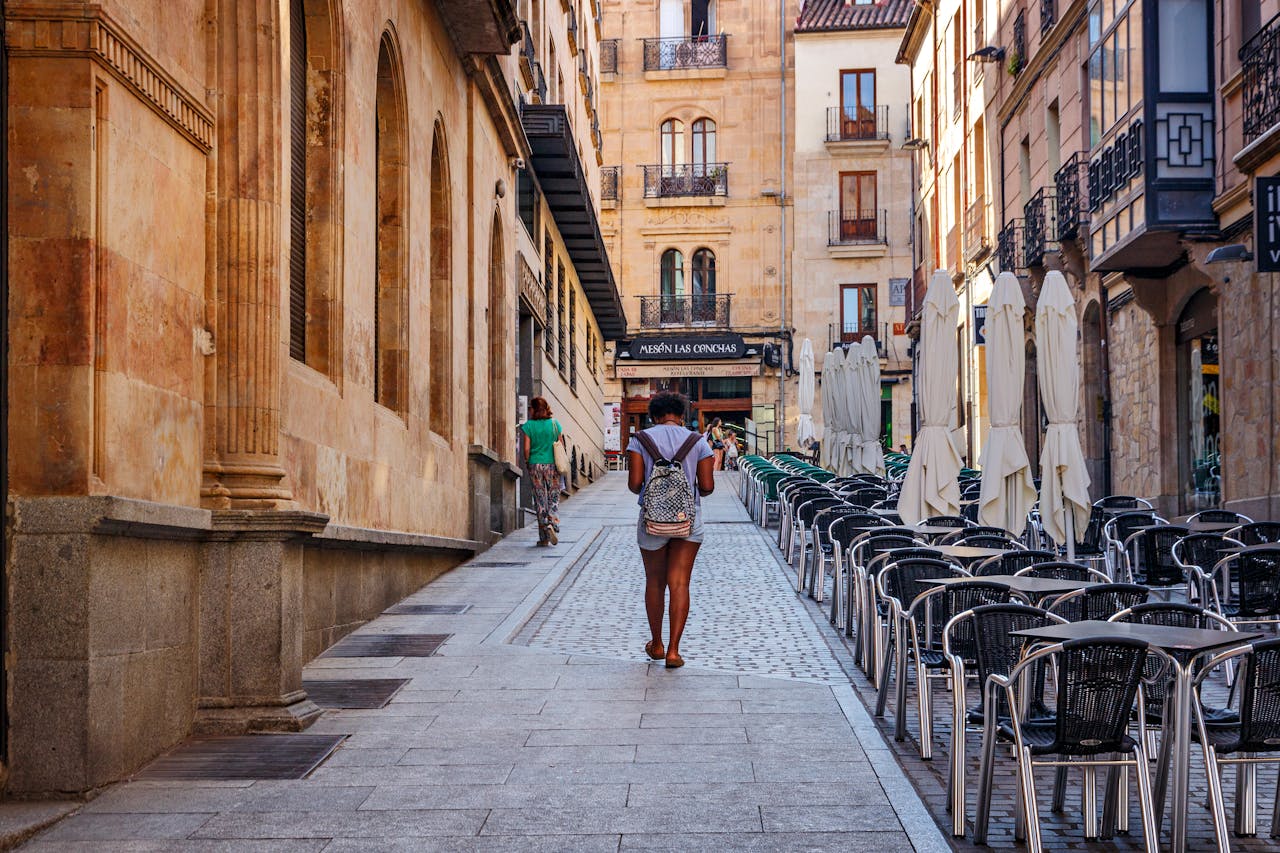
Cost of Master’s in Spain
What Does a Master’s in Spain Really Cost? Tuition, Living, Visa Fees, and Funding (2025)
Last updated: September 22, 2025
Thinking about getting your master’s in Spain and trying to pin down the real price tag? This guide breaks down your costs into clear buckets—tuition, living, visa/one‑time fees, and funding options—with current figures and plain‑English explanations for U.S. students. It’s university‑agnostic and uses examples you can verify on official pages before you apply. If you’re comparing options, this guide gives you the real master’s in Spain cost for 2025 so you can budget with confidence.
Not sure which program or city fits? Take the 60-second fit check.
Exchange-rate note: When converting to USD, use €1 ≈ $1.18 (wise.com, Sept. 22, 2025).
Quick Answer: Master’s in Spain Cost (2025)
A typical public 60‑ECTS master for non‑EU students lands around €2,700–€6,600 in tuition depending on region/pricing band. Expect ~€800–€1,250 per month for living costs (city + housing), and plan for student‑visa, TIE, and insurance.
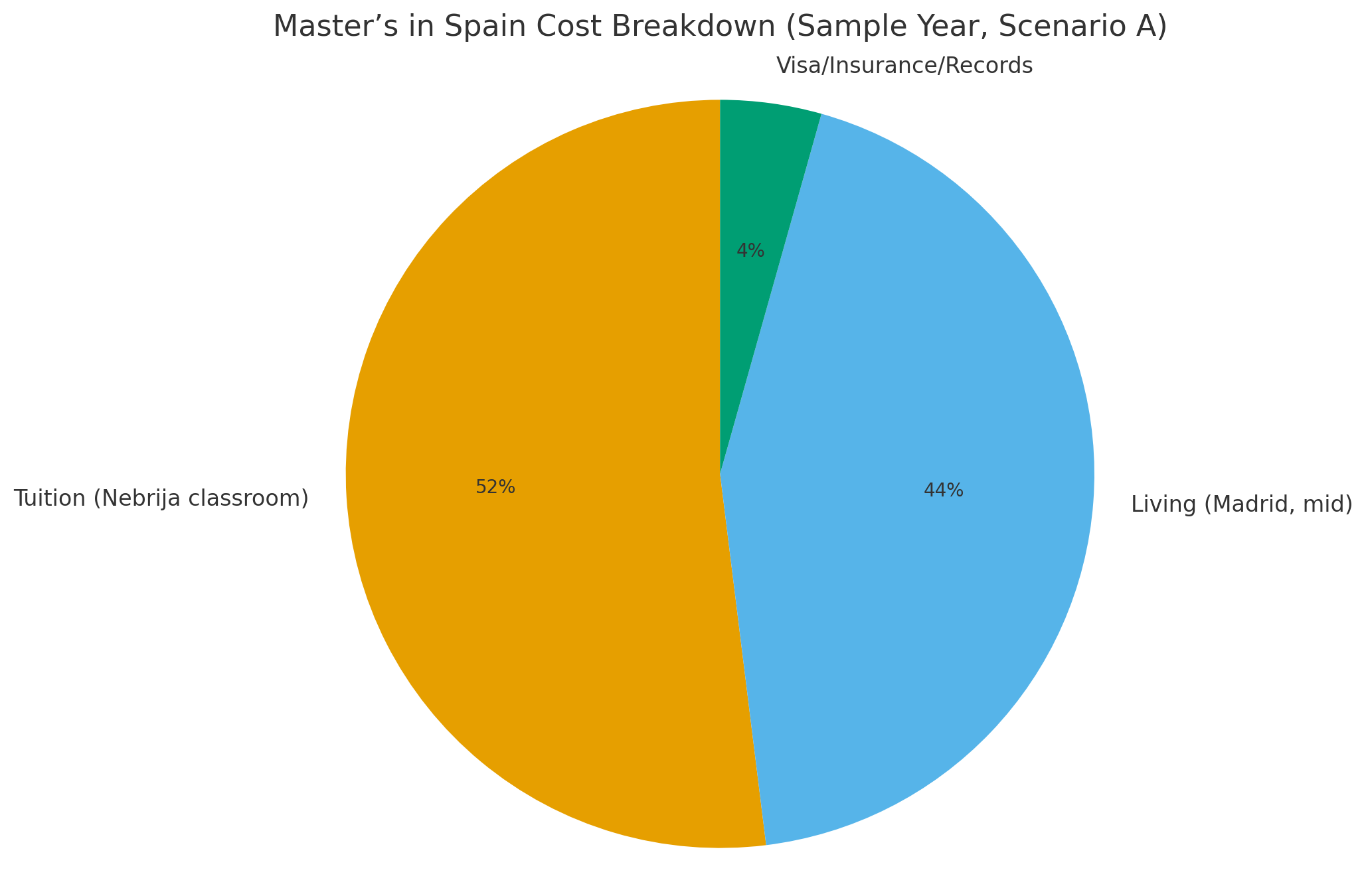
How the Master’s in Spain Cost Is Calculated (ECTS & Credits)
- Spain uses ECTS: a full academic year is 60 ECTS (1,500–1,800 total hours).
- Roughly, 2 ECTS ≈ 1 U.S. semester credit.
- Official vs propio: official degrees (public or private) are state‑recognized and appear in RUCT; propio are institution‑awarded continuing‑ed programs. Always confirm the status on the program page.
Master’s in Spain Cost: Tuition (Public vs Private)
Public Universities: Master’s in Spain Cost per ECTS
Tuition is set per credit and varies by region/program type. Examples commonly used for non-EU students:
- Madrid example (many non‑enabling master’s): ~€45.02/ECTS → ≈ €2,701 for 60 ECTS at first enrollment (UCM pricing)
- Catalonia example (some universities apply a non‑EU rate): €110/ECTS → ≈ €6,600 for 60 ECTS (e.g., Universitat de Barcelona)
How to Verify: You can confirm rates on your program’s tuition page and your region’s official fee decree.
What to check on the program page:
- Non‑EU pricing band (if any)
- Surcharges for repeated enrollment
- Whether your track is habilitante/enabling (regulated professions often price differently)
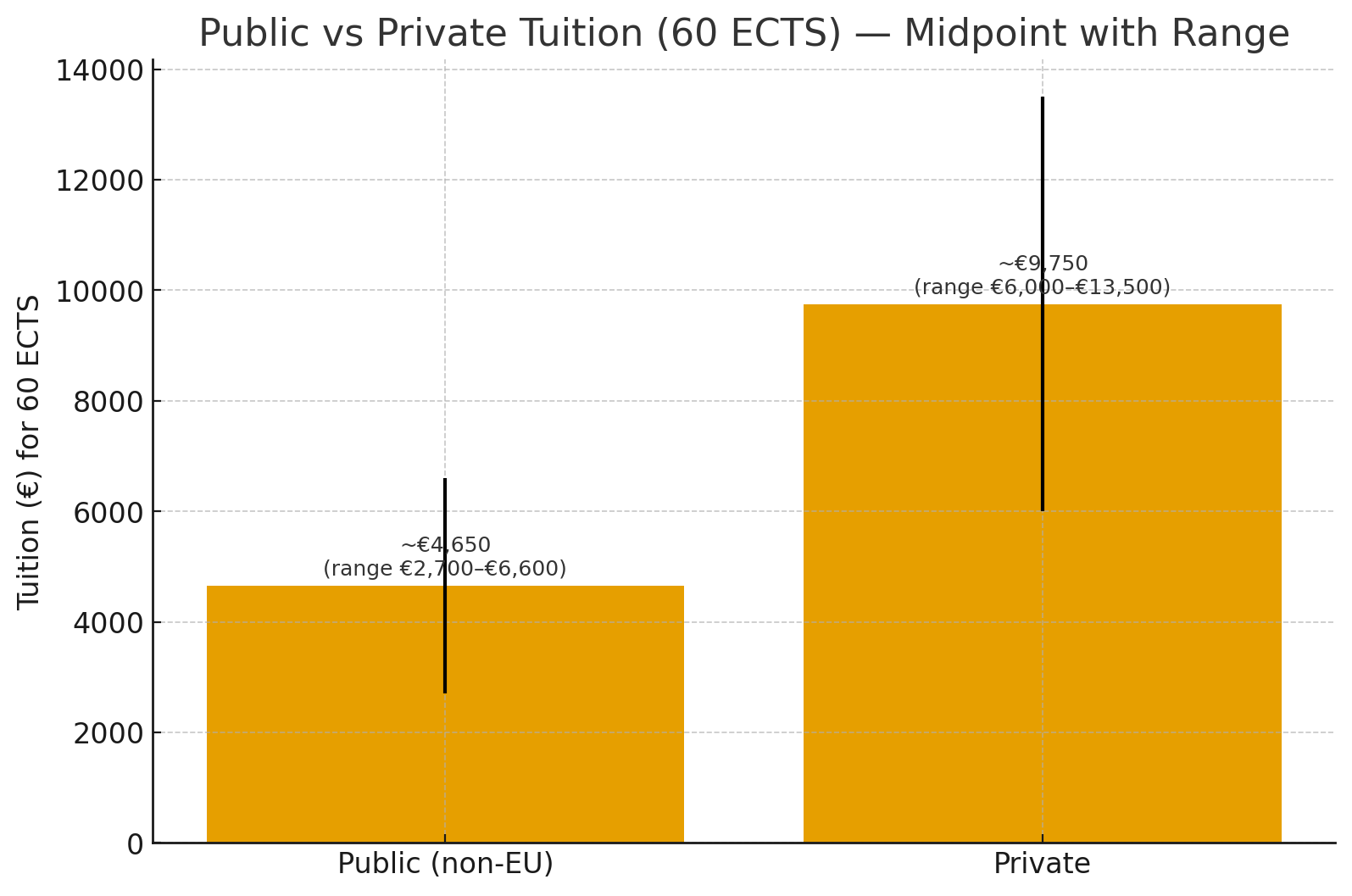
Private Universities: Master’s in Spain Cost by Program
Prices span widely—from premium business schools to very affordable options. For reference, Nebrija University (Madrid), a notably affordable private option, lists examples like:
- Business Analytics: €13,500 (classroom) or €8,300 (online)
- Leadership & Strategic People Management: €11,900 (classroom) or €6,000 (online)
- Sales Management & Data: €11,900 (classroom) or €6,200 (online)
- Security & Defense (online): €6,200
- Industrial Engineering 120 ECTS/2 years: €18,000 total (split across years)
Key Takeaways:
– A typical public 60 ECTS master for non-EU students in 2025 can be €2.7k–€6.6k+ per year depending on region and any non-EU price band.
– Nebrija is generally priced below many premium private universities in Spain and often falls in the €6k–€13.5k bracket for one-year programs (classroom/online).
Tuition at a glance
| Degree Type | Pricing Model | Typical range (60 ECTS, ~30 U.S. Credits) | Notes |
| Public (non-EU) | €/ECTS by region | €2,700–€6,600+ | Catalonia often higher; check repeat‑enrollment rates |
| Private | Flat per program | €6,000–€13,500+ | Big spread by school; online vs classroom can vary a lot |
Master’s in Spain Cost by City: Realistic Living Costs
Every student’s lifestyle is different, but these university-provided ranges are a solid baseline. Ranges below assume a shared flat and cooking at home. Residences or solo apartments will cost more.
| City | Lean | Comfortable | Transport pass (monthly) |
| Madrid | ~€800–€1,000 | ~€1,100–€1,300 | €10 Abono Joven (15–25) · €32.70 Zone A (26+) — CRTM / Metro Madrid |
| Barcelona | ~€850–€1,050 | ~€1,150–€1,250 | €22 T‑usual (1 zone, 30‑day unlimited) — ATM / T-mobilitat |
| Valencia / Granada | ~€700–€900 | ~€950–€1,100 | ~€30–€50 (local operator) |
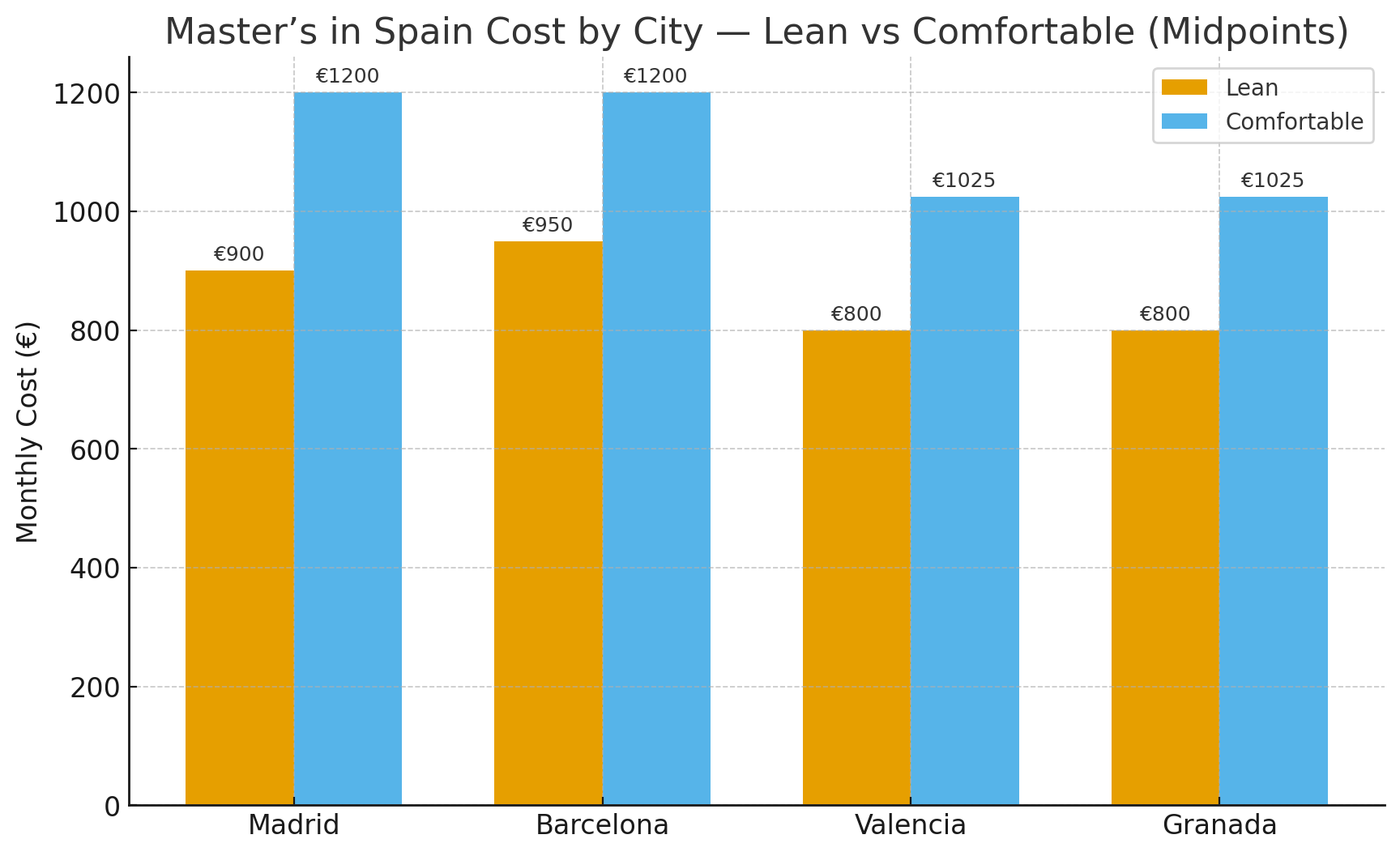
What changes the monthly number: neighborhood, room vs residence, utilities included, and how often you eat out. In Madrid and Barcelona, living just outside the center reduces rent meaningfully.
Tip: If you’re under 26 in Madrid, the €10 monthly pass is a huge saver. Barcelona’s T‑usual €22 remains a strong value for a 1‑zone commute.
Master’s in Spain Cost: Visa, Health Insurance, & One-Time Fees (U.S. Students)
Budget these in USD (consular fees) and EUR (in-Spain fees). Always confirm at your jurisdictional consulate.
- Student visa fee (U.S. citizens): $160 (+ typical $18–$19 BLS service fee) (Miami Consulate and BLS Washington)
- FBI background check: $18 — FBI: Identity History Summary Checks
- Apostille (U.S. Dept. of State): $20 per document — Travel.state.gov: Authentication/Apostille
- TIE (residence card) fee in Spain (Modelo 790‑012): around €16.08 for the initial card (exact fee listed on the Spanish National Police schedule for Modelo 790-012; legal sites often cite typical amounts, e.g., Balcells Group).
- Health insurance: must cover your full stay with no deductibles/copays; many consulates explicitly say this. Budget varies by provider. (Check your consulate’s student visa page).
- Proof of funds (IPREM): most consulates require 100% IPREM per month of stay. In 2025 many posts still apply ~€600/month as the reference. (Check your consulate’s checklist).
Reality check: Some housing requires 1-2 months’ deposit; plan your cash flow even if your ongoing rent is moderate.
Build Your Visa Plan (U.S. Students)
Consulate-specific checklists, insurance wording, FBI/apostille timing, and packet reviews.
Plan my visa steps.
Master’s in Spain Cost: Sample All-In Budgets (10 Months in Spain)
These combine example tuitions with mid‑range student living (shared flat) and typical admin costs. Flights not included. Adjust to your city and program.
A) Nebrija classroom private program in Madrid (e.g., International Relations, 60 ECTS / ~30 U.S. Credits)
- Tuition: €11,900 (classroom) — Nebrija
- Living: ~€9,500–€10,500 (≈ €950–€1,050 × 10 mo) — UC3M
- Insurance + visa/TIE/records: €800–€1,200 (policy + $160 visa + service + $18 FBI + $20 apostille + TIE) — BLS Spain; Balcells Group
Estimated total (10 months): ~€22,200–€24,600 (+ flights)
B) Nebrija online private program while living in Madrid (e.g., Sales Management & Data)
- Tuition: €6,200 (online) — Nebrija
- Living: ~€9,500–€10,500 — UC3M
- Insurance + visa/TIE/records: €800–€1,200 — BLS Spain; Balcells Group
Estimated total: ~€16,500–€18,900 (+ flights)
C) Nebrija online private program while living in a lower-cost city (e.g., Valencia/Granada)
- Tuition: €6,200 (online)— Nebrija
- Living: ~€8,000–€9,000 — UC3M
- Insurance + visa/TIE/records: €800–€1,200 — BLS Spain; Balcells Group
Estimated total: ~€15,000–€16,400 (+ flights)
You can build similar scenarios for public tuition by inserting your ECTS × €/ECTS rate and the city line that matches your plan.
What Drives Your Master’s in Spain Cost Up or Down
- Region & non‑EU band (public): e.g., Catalonia often lists higher non‑EU rates; Madrid examples around €45/ECTS.
- Delivery mode: Online options can halve tuition vs classroom.
- Age & transit profile: Madrid under-26 €10 vs €32.70 (26+); Barcelona €22.
- Housing type/location: Shared flat vs residence can swing €200–€400/month.
- Working while you study (offset your costs): Spain allows international students to work up to 30 hours/week alongside studies (subject to compatibility). See official guidance: inclusion.gob.es; legal overview: Balcells Group.
Ways to Reduce Your Master’s in Spain Cost
- University discounts/merit awards: Check faculty pages; public universities may have fee relief for certain categories (region-specific, e.g., Comunidad de Madrid).
- External scholarships: Fulbright, Gilman (if doing exchanges), field‑specific foundations.
- Choose neighborhoods just outside city centers for lower rent.
- Leverage student transport passes (Madrid under 26 Abono Joven; Barcelona T‑usual).
- Cook at home + share utilities to stabilize monthly costs.
The Compliance Checklist (U.S. Students)
- Visa appointment & fee: $160 + BLS service ($18–$19). See BLS Spain Visa and your consulate’s page.
- Proof of means: 100% of IPREM per month (many consulates cite €600/month). See your consulate’s checklist.
- Insurance: No copay, no deductible, full coverage for the entire stay; multiple consulates (e.g., Boston/Chicago) state this explicitly.
- FBI check & apostille: $18 + $20 per apostille — FBI; U.S. Dept. of State
- TIE after arrival: Pay Modelo 790–012 fee (≈ €16.08 for initial card) and complete fingerprints/issuance — Policía Nacional; Balcells Group
FAQs
How much does a master’s in Spain cost for international students?
Public tuition for 60 ECTS commonly runs ~€2,700–€6,600+ depending on region and pricing band; private programs vary widely (€6,000–€13,500+). Add €800–€1,250/month for living by city.
Do non-EU students pay more at public universities?
Often yes—some regions/universities apply a higher non‑EU €/ECTS rate. Confirm on the program page.
How much money must I show for the student visa?
Many consulates reference IPREM ~€600/month of stay; exact wording varies by consulate and scholarship/housing letters. Verify locally.
Can I work to offset costs?
Yes—rules currently allow up to 30 hours/week alongside studies (subject to compatibility). Treat income as a cushion, not full funding.
Is health insurance required? What kind?
Yes. Policies must cover the entire stay and typically exclude deductibles/copays to meet consular requirements.

Program Shortlist & Arrival Plan—Tailored to You
University-agnostic support: shortlisting and city fit, documents and SOP, visa steps, housing, and day-one logistics.
Methodology & Sources
Figures are drawn from official university and government pages (examples below). USD shown (where helpful) at €1 ≈ $1.18 (Wise, Sept 22, 2025).
- Tuition (public examples): UCM – master’s prices (Madrid); UB – master’s pages (Catalonia)
- Living ranges: UC3M – Cost of living, Madrid; UPF – Cost of life, Barcelona
- Transport: Metro Madrid tariffs; ATM/T-mobilitat T-usual
- Visa & fees: BLS Spain – Washington; Miami Consulate – Student Visa
- Records & apostille: FBI – $18 fee; U.S. Dept. of State – $20/apostille
- TIE fee: Policía Nacional – Modelo 790-012; Balcells – typical amounts
- Work while studying: Ministry of Inclusion (overview)


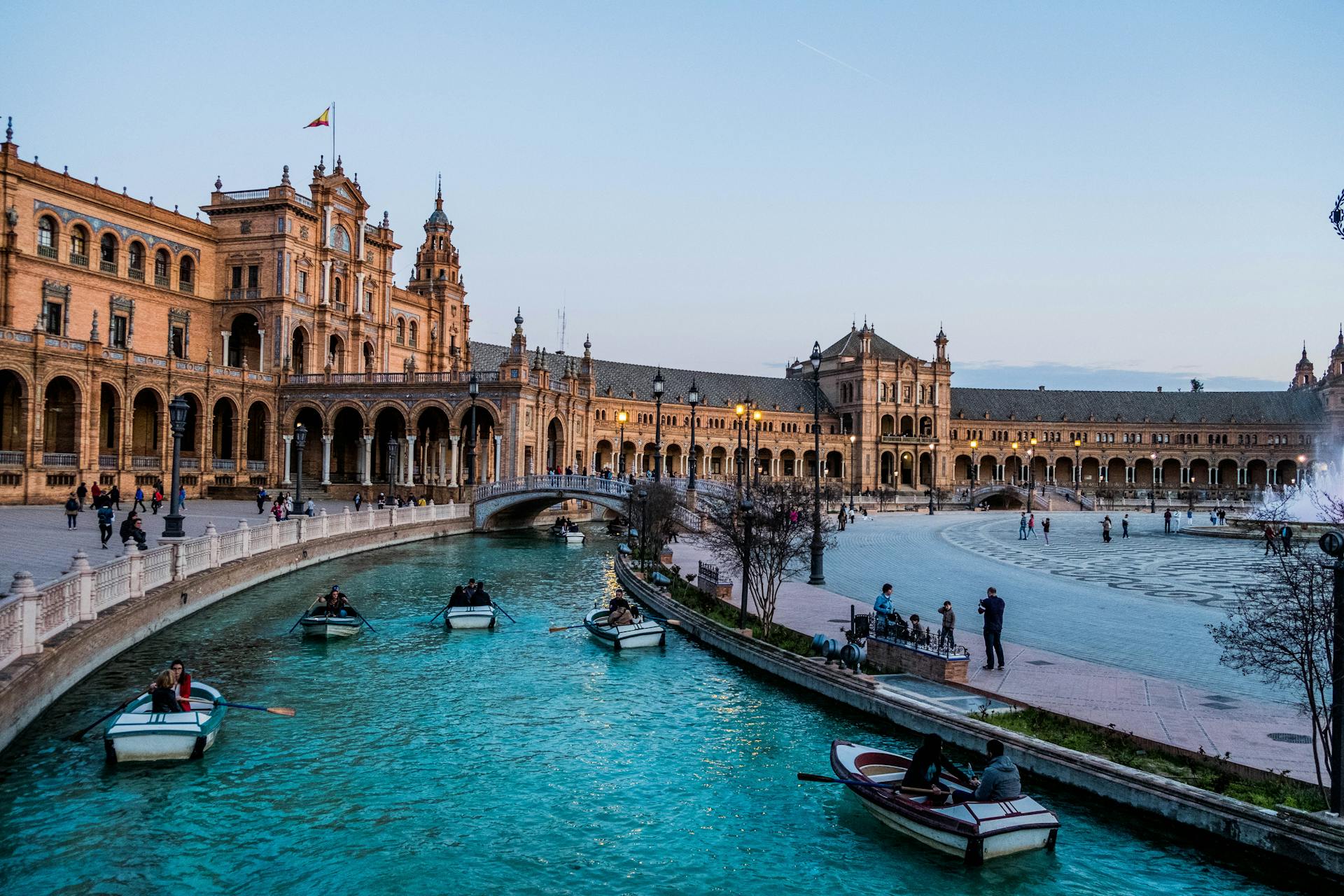






 RVF Participant Shaniya with her students.
RVF Participant Shaniya with her students.
